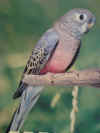BOURKES
Parakeets
(Snippets of info. you may not have known about these quiet, inoffensive little
birds
that are a great and colourful addition to any small-bird Aviary)
-
As they originate from the dry,
arid areas of Australia, they have evolved to survive on "poor
pickings"
Their digestive system is designed to best utilize what it
extracts from a diet of mixed seeds,
inc. "weed-seeds"
+ tree/bush buds.
-
Also, it is able to extract moisture out of the
seeds and dry grasses like "spinefax"
(an Aus. Desert grass -) + bark off trees and
bushes inc. Eucalyptus bushes. It's digestive
system is not used to
our "juicy" English grass!
-
Some
English WEED SEEDS you can offer: Chickweed, Curly Dock seeds,
Shepherds Purse,
Plantain ("Rats Tails") offer when seeds are dark brown,
Dandelion seeds when dk. brown
- cut fluffy white heads off and feed (just
b4 it opens out and becomes the "dandelion clock").
Seeding grasses when
standing Hay is ripe and ready to cut.
(Canaries & Budgies and most other parakeets love all the above also).
-
Feed
minimum
Sunflower and safflower seeds (if any)- as these seeds are too oily and rich
for them.
They are a bit like a "Camel" of the
bird-world and can exist and thrive on meagre pickings.
-
So you aren't
doing them any favours over-indulging them in rich foods etc.
|
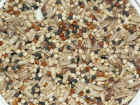 |
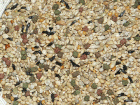 |
Both
these seed mixes are ideal for Bourkes, as they contain a good
mix of small seeds that are easily digested.
I also
add extra plain canary seed to the seed mix.
They also appreciate Millet Sprays. |
Budgie
Tonic Seed
Linseed, groats, black rape, millet-mix, Niger, safflower. |
Waxbill
Seed Mix
Plain canary, sml. millet mix, Niger, linseed, hemp, + bisc-mix |
<< Click
on the pictures to enlarge |
-
Becos they originate from an arid
area, they tend not to eat moist fruit and veg. and can get
digestive
disorders inc. diarrhoea if fed with lettuce or similar "wet" veg.
-
They will nibble on a fresh
carrot & Celery + bits of sweet apple, Broccoli and love Sweetcorn + Egg food
-
They
do not tend to bathe
a lot (but will bathe
if you
provide a bath).
-
They
do love being under
light rain showers.
-
They
DO need plenty of
fresh
air -
but not draughts
-
- so make sure Aviary is sheltered from
cold winds (and rain) blowing directly in during
winter months
-
Usually winds/weather from North and East are the colder.
-
they
must have fresh air
-
So if
you are leaving a side of the Aviary open to the elements - make
it the south-facing side.
-
If
they are in an Aviary, it's a good idea to give them a wooden
shelter to shelter or roost in. (see picture)
►
-
They are most active in the early
morning and early evening (i.e. dawn and dusk)
that is why
they have bigger
eyes, which denotes a nocturnal type of creature.
-
From late morning
and into the
afternoon they siesta quietly, in shaded parts of the Aviary
and are at their least active. Which is what they would do in their natural habitat,
the Australian Outback, during the hottest part of the day. They would
try and find somewhere shaded
and cool, to rest, amongst the shrubby thorn
trees.
-
So try and provide a shaded area for them in their Aviary.
-
They
don't like their Nestboxes to be in direct sunlight either.
-
They must have a good flying
space but also lots of variable size branches incl. lots of
little thin
"twiglets" hanging in all directions, to
encourage them to exercise their feet and teach them
dexterity
and balance.
-
They love to strip the bark and nibble the buds.
SEXING
-
Mutation Bourkes are mono-morphic
(i.e. visually very similar in colouration).
-
So, it's very difficult
to tell the sexes apart, esp. when the birds are immature
i.e. under 4 - 6 months, when they go thru their juvenile moult.
-
cocks tend to show
maturity sooner than hens and can "display" fairly soon after
they
have gone thru
their first moult - if conditions are right
i.e. mixed aviary with mature, active hens.
-
If there a few
Cockbirds tho, the more dominant cockbirds WILL DISPLAY while
the more subservient ones may not while in that Aviary
environment.
-
You may need to
separate a "Cock" and Hen together to see the Cock display.
-
Some people say that the Cock
birds have a longer, flatter slope to the top of their heads.
-
Cockbirds are slightly bigger and
appear bolder than the hen with a brighter appearance/colouration.
-
(Once
they have gone thru. their first moult).
-
Lutino Cockbirds tend
to have a lot less white on their faces than hens and can
sometimes be
just a deep pink with next to no white at all round
their heads and faces.
Before the first moult,
immature birds all tend to look like a hens. -
Hens tend to be slightly smaller
in size and be lighter or a slightly duller colour.
-
Hens have a slightly smaller,
rounder-shaped head.
-
HENS will
Bite
(with intent)
when handled and can "growl"
-
all defense mechanisms to ward
off predators when they are protecting their own nests.
-
This tendency is
often an easy way to help "sex" a lot of parakeets, even when
they are
still in the nest - the hens will bite and the cocks
may give you a nip but nothing serious!
-
Cock birds are much milder
mannered.
-
They may bite if handled but not with the same intensity as a hen
would.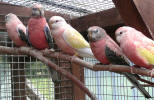
-
One thing I have
noticed is that if you have a row of Bourkes on a perch together
~ the ones that sit more "upright" are usually the Cock birds
and the ones that are on a more "horizontal" plane, are
usually then Hens
-
22nd
Feb. 2007 seemed to be the "first day of Spring"
this
year
-
2 of the Bourkes that my friend
has and was unsure of their sex, started to perform
courtship "Displays" both at the same time and going
thru the same "performance",
to prove they were
indeed Cock birds.
COURTSHIP DISPLAY (as observed)
~ Cockbird 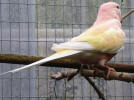 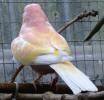
-
Both Birds flew quite
positively onto branches.
-
They landed heavily, almost with a
definite thump, as they held their wings away from their
bodies to
make themselves look bigger.
-
They looked like wide
"canopies" from behind, with their bodies just above the
horizontal,
as they landed on the branch.
-
Then they then
stretched their bodies and head up to full height and bobbed down
a couple of times.
-
They hold their wings
away from their bodies (a bit like Concorde) & arc their
backs, as they are performing these movements.
-
Some cock birds
actually tap their beaks on the branches as they are doing the
bobbing.
-
They repeated this
numerous times and as one bird displayed the other seemed to copy
almost simultaneously.
-
I must admit the hens
weren't particularly impressed but then this was just the
"First Day of Spring"!!! (to them too!)
-
Normal-coloured Bourkes are much
easier to sex, once they have gone thru their first moult,
approx. 6
months, as the Cockbird has a distinct blue line across the top of the
Beak, a
white strip
thru the eye-line and blue on the
"Shoulders" of the wings
-
Make sure they have
oystershell
and mineralized grit, cuttlefish bone and iodized nibbles,
esp.
when breeding - this should supply most of the calcium and
minerals needed for the hen to form
her eggs without drawing calcium from her bones.
-
They lay 4 - 8 eggs
-
Incubation : 17-19 days
(depending on when they start to incubate ~ I have noticed
that they do NOT start incubating from
when
they lay their first Egg - often after 2nd, 3rd or even later).
-
So, take this into
consideration when calculating when the first egg would be due
to hatch
-
Usually it's about
23 days from first egg laid to first chick hatching and often 2
chicks will hatch together.
-
Then another often
hatches the following day
-
From then on -
they hatch every other day.
-
The first Egg has
been known to hatch up to 7 days after their due date
-
cos the Hen hasn't
started to incubate until 3rd-4th Egg laid.
-
So, don't be too
impatient to discard the eggs thinking they aren't viable!
-
It is best ALWAYS
to let the hen decide for herself, when the eggs are not viable
-
-
at which point she
will either abandon them
-
Kick them to the
back of the nestbox
-
or kick them out
of the nest, ready to start again.
-
Then
often the following eggs hatch every consecutive day rather than
every alternate day
-
(which is how
they were laid)!
-
I presume this is
so that the chicks are closer together size-wise.
-
Which should help
prevent sibling rivalry
-
and the bigger
chicks getting all the food
-
plus avoiding the
possibility of the smaller ones being crushed or starved.
-
HATCHING :
Budgie chicks are naked when they hatch, whereas Bourke chicks
are covered
in a fine white
down (similar to Cockatiels).
Their
skin colouration appears deep pink-
click to see photo►
-
CLOSE RINGING
: 14 - 16 days
-
(slightly later than a
Budgie cos their legs
and feet are more dainty, even tho Ring size
is the same
-
Ring Size : L (same as Budgies)
-
2007 Ring colour :
BLACK
+ white inscription
(usually your initials > 07 > consec.
nos)
-
2008
Ring Colour :
Dark Blue + white inscriptions
-
2009 Ring Colour :
Violet
+ white inscriptions
-
FLEDGING: approx. 28 - 32days (similar
or slightly earlier than Budgies)
-
I put coloured split
Rings on the opposite leg to the closed ring and use the same
colour for all the chicks in that nest .
-
i.e.
GREEN for one pair of Birds, (Poss.
RED for another Nest of chicks)
so all their young can be identified as belonging to that pair
of birds, once they are in the Aviary flying around.
-
As they all
can look so similar.
-
I also put the closed
ring on alternate legs of each chick (once again to help quickly
identify them)
-
i.e. on the left leg
of the eldest chick and then on the right leg of the next oldest
and so-on.
-
Or if you have 2
rosa's in a mixed-coloured nest of chicks - you can put the closed rings on the opp. legs
to each other.
-
The Cockbird chooses the Nest
site (or Nest box in our case)
-
NESTBOXES
for Bourkes are better to be on the neat side size-wise as the
hens take up very little space
-
They tend to look
like little torpedos - i.e. long and narrow, when they are
incubating.
-
- they also can
scatter their eggs, which is a waste if they chill.
-
I find this size
seems to work well 12" high x 5 1/2 - 6" wide 8" deep.
With 1 3/4" diam. pop-hole.
-
It's the width
that is the criteria - too wide and it's just too big
-
Make sure there is
a fairly wide concave in the bottom of the nest box too, so that
if the hen does scatter the eggs then they roll back into the
middle and don't stay on a flat bit away from the hen's warmth,
which is needed for successful incubation
-
The Hen, cleans it out and
prepares it for use.
WARNING******
-
Make VERY SURE that you
do NOT put too much bedding in for them.
-
Budgies / Bourkes don't
really need any bedding - just a wooden concave base.
-
They may benefit from a
Little sprinkle of bedding i.e.
Easibed wood chip to help stop
the eggs rolling around and becoming chilled and also to
help prevent
"Splayed Legs"
as
the chicks have something to push against - a slippery
surface is a big "no-no"!!
-
A friend made a big
mistake by putting over 1" in the bottom of her nestboxes,
thinking
she was being kind and making the birds "comfortable".
-
She lost nearly all her first round of chicks off a few hens, as
they got buried, lost or chilled.
-
SO BE VERY AWARE as it's
very upsetting to find unnecessary dead chicks.
-
The Hen does all the incubating.
-
General rule of thumb is approx.
2 weeks from 1st mating to 1st egg being laid
(this applies to a lot of
birds and is a rough guide).
-
They don't seem to
start incubating until the 3rd Egg has been laid - so even
though 18 days is the incubation time, you really need to add 5
days to this = 23days b4 they do start to hatch then you
often get a couple hatching together and then again the
following day one or 2, which can throw your calculations out if
you are not used to this!
-
The Cockbird feeds her and guards
the Nest while she's sitting.
-
They need
worming regularly as they are Floor foragers.
-
They mix well in an Aviary, as they
are a very quiet breed of bird.
-
I have bred a pair in
an Aviary with Budgies that were also breeding
-
- no problems as long
as they were introduced at the same time
-
Don't introduce
a new pair of any breed of bird if any one pair
has chosen it's nestbox and been in the Aviary enough time to
claim
it as it's own territory - then you might have problems.
CARDIAC-RACING SYNDROME (Heart
Attacks)
-
Bourkes can
be prone to Heart attacks if they get mega stressed
-
If this happens put the bird quickly and gently into a quiet,
dark place to let it, hopefully, recover.
-
Cocks are slightly more prone to this than hens,
-
who
are more likely to give you a hard nip, if caught up
-
(as they would when
protecting their nest boxes)
-
but they can still end up the same, if great
care is not taken.
^Top

|


